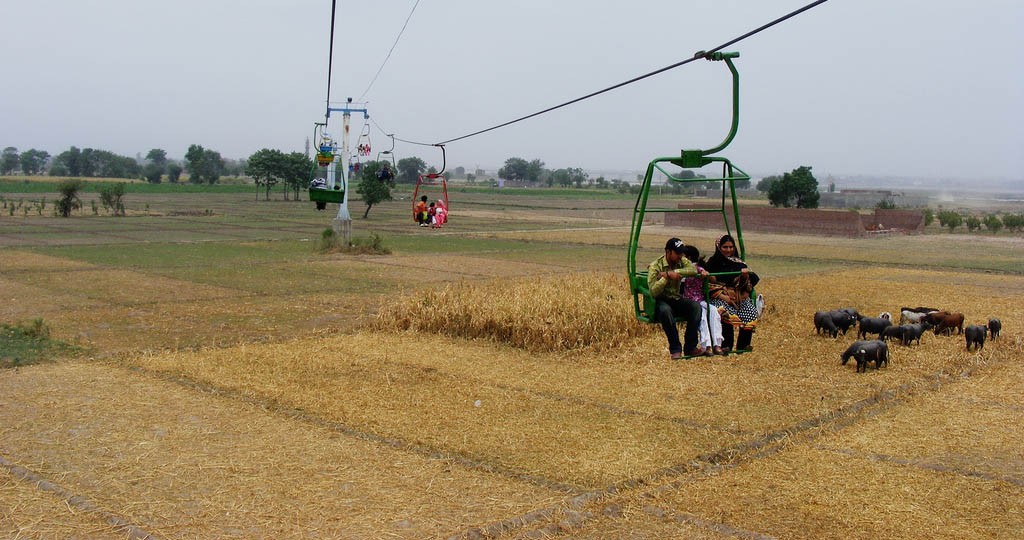
The proposed Canal Chairlift Project, which is not part of the Lahore Master Plan, will need to be developed in the light of the prescribed rules and regulations

After toying with the idea for a long time, the Punjab government has finally announced running a chairlift above a 22-kilometre long stretch of the canal, from Jallo Mor through Thokar Niaz Baig. As ambitious as it sounds, the project -- which is right now at a preliminary stage of conception -- has garnered criticism from different quarters.
Before any headway is made on the proposal, it is imperative that the financial crunch, a shrinking investment, the energy crisis, management issues, legal hitches and environmental hazards are taken into account.
Interestingly, the political leadership is not on the same page when it comes to giving shape to the idea. PPP, PML-Q, PTI and PML-N are said to have differences on the project and do not seem likely to meet halfway.
But the high-ups in the Punjab government and the civil bureaucracy have already dubbed it as ‘doable’, if only funds are made available.
The environmentalists, on the other hand, say any such project is welcome, provided the canal ecology and landscape stays unhurt.
The legal part is perhaps the most significant as it may impede any initiative on the project. It is believed that any sort of construction and/or infrastructure development work on the canal is off-limits. Section 3(5) of the Lahore Canal Heritage Park Act, 2013 clearly states that no matter if the work is for public welfare, all prescribed procedural requirements must be completed. This entails that the government must prove that the project will not deface the originality of the canal and that the environmental aspect shall not be compromised. Further, if the government aspires to undertake any infrastructure projects, the Parks and Horticulture Authority (PHA) must also be taken on board.
Ahmad Rafay Alam, Member, Canal Heritage Park Advisory Committee (CHPAC) is of the view that the Lahore Master Plan, which envisions development work in the next 10 to 20 years, does not include the chairlift project over the canal.
"If it must be made, in the greater interest of the public, it has to be substantiated that there is no clash with the various factors enshrined in the master plan," he argues.
Sources privy to the project say the idea of the Lahore Chairlift popped up before the Punjab government back in 2013. The Lahore Development Authority (LDA), the Department of Agriculture, the PHA and the Tourism Department were all instructed to prepare a feasibility report to this effect. Swiss, German and Canadian companies were approached and the project cost was determined to be Rs500 million. It was planned that the cable chairlift would run around 45 feet above the canal.
Israr Saeed Khan, a senior LDA official who is now working as TEPA chief engineer, can’t stop singing praises of the project. He says the city lacks recreational facilities and the chairlift has a great potential to entertain the public.
As for the challenges posed by long, unannounced power outages, Khan suggests an independent electricity unit be made operational.
However, he admits that the project is only at the "concept level… [and] needs to be worked out with complete technical and administrative expertise."
In the recent past, a Turkish company had proposed a similar project and also briefed the CM Punjab on running 50 chairlifts above the canal at the cost of Rs650 million.
Sohail Janjua, an LDA spokesperson, shows utter ignorance about the project and categorically denies having worked on it. "This project is only a rumour; nothing else," he declares.
"Neither the Punjab government nor any of its department ever contacted the LDA to draft the chairlift project. I don’t know where and how this kind of gossip started."
More recently, PAT Punjab President Basharat Jaspal lashed out at the proposal, terming it a waste of resources in the name of recreation: "The project may cost up to Rs20 billion. Besides, it only means to please the CM Punjab who is hell-bent on conferring contracts to his blue-eyed people.
"The funds had better be consumed on education and health sectors instead," he said.
PML-N senior leader Muhammad Mehdi says the chairlift project is supposed to improve the physical and psychological health of the public and foster communities, and make cities and neighborhoods more captivating places to live and work in.
Nonavailability of recreational facilities is strongly linked to the rise in crime, particularly juvenile delinquency, Mehdi claims.
Chairlift, an elevated passenger ropeway, which is traditionally made of a continuously circulating steel cable loop strung between two ends of a terminal, usually over intermediate towers, is always a highlight at recreation parks, especially in hilly areas. Pakistan has one very popular chairlift in Ayubia, Murree.
Lahore hailed its first chairlift project at the Ravi river, near Saggian bridge, in 2002. It was a private project, carried out by an individual named Muhammad Aslam. On account of some technical faults, it was discontinued. It became functional again in 2011. Since it had no government patronage, seldom people came to know about it. Little or no publicity also contributed towards keeping this recreational facility in a low profile.
Presently, the chairlift is run only on Sundays, from Saggian bridge up to the Motorway, and its total length is 2 kilometres.